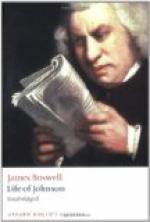that tradition said so; and that there was a ruin
remaining of their church, which had been burnt:
but I confess Dr. Johnson has weakened my belief in
remote tradition. In the dispute about
Anaitis,
Mr. M’Queen said, Asia Minor was peopled by
Scythians, and, as they were the ancestors of the Celts,
the same religion might be in Asia Minor and Sky.
JOHNSON. ’Alas! Sir, what can a nation
that has not letters tell of its original. I have
always difficulty to be patient when I hear authours
gravely quoted, as giving accounts of savage nations,
which accounts they had from the savages themselves.
What can the
M’Craas[619] tell about themselves
a thousand years ago? There is no tracing the
connection of ancient nations, but by language; and
therefore I am always sorry when any language is lost,
because languages are the pedigree of nations[620].
If you find the same language in distant countries,
you may be sure that the inhabitants of each have
been the same people; that is to say, if you find the
languages a good deal the same; for a word here and
there being the same, will not do. Thus Butler,
in his
Hudibras, remembering that
Penguin,
in the Straits of Magellan, signifies a bird with a
white head, and that the same word has, in Wales,
the signification of a white-headed wench, (
pen
head, and
guin white,) by way of ridicule,
concludes that the people of those Straits are Welsh[621].’
A young gentleman of the name of M’Lean, nephew
to the Laird of the isle of Muck, came this morning;
and, just as we sat down to dinner, came the Laird
of the isle, of Muck himself, his lady, sister to Talisker,
two other ladies their relations, and a daughter of
the late M’Leod of Hamer, who wrote a treatise
on the second sight, under the designation of THEOPHILUS
INSULANUS[622]. It was somewhat droll to hear
this Laird called by his title. Muck would
have sounded ill; so he was called Isle of Muck,
which went off with great readiness. The name,
as now written, is unseemly, but it is not so bad
in the original Erse, which is Mouach, signifying
the Sows’ Island. Buchanan calls it INSULA
PORCORUM. It is so called from its form.
Some call it Isle of Monk. The Laird insists
that this is the proper name. It was formerly
church-land belonging to Icolmkill, and a hermit lived
in it. It is two miles long, and about three
quarters of a mile broad. The Laird said, he
had seven score of souls upon it. Last year he
had eighty persons inoculated, mostly children, but
some of them eighteen years of age. He agreed
with the surgeon to come and do it, at half a crown
a head. It is very fertile in corn, of which
they export some; and its coasts abound in fish.
A taylor comes there six times in a year. They
get a good blacksmith from the isle of Egg.
SUNDAY, SEPTEMBER 19.




